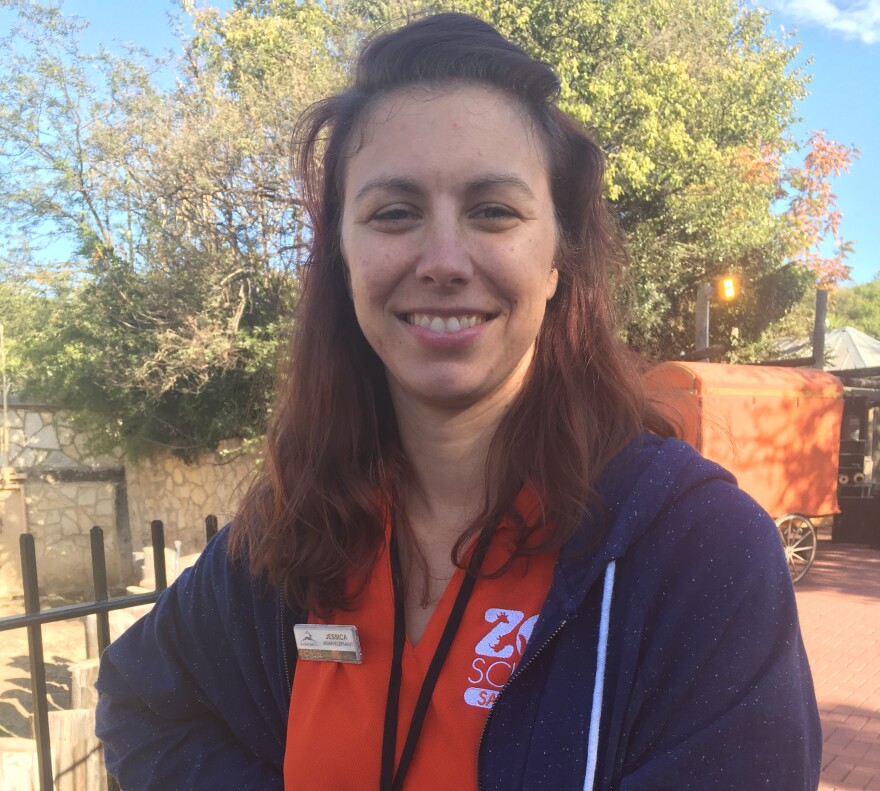Sixty four kids in San Antonio get to go to school with tree kangaroos, crocodiles and jaguars. The San Antonio Zoo’s “Zoo School” has been a fully licensed preschool since 2014. When it expands next fall, it will serve up to 300 children.
The morning at the San Antonio Zoo smells sweet like animals and fresh air. There’s foliage shading the paths. Large lollipops decorate the fence posts. A giant snow globe stands off the path with gingerbread figurines inside, candy canes, frosted Christmas trees and a plastic giraffe. If you're three to five years old, that might be a pretty cool place to call school.
The children take walks, holding onto plastic loops to stay somewhat in a line. They have lessons about the birds, reptiles, and mammals they see along the way.
“My friends you can let go of the loops and have a seat on this edge,” says Jessica Hara. She’s the lead teacher at Zoo School. Today she has 11 students in her class and they’ve just sat down on a low stone wall in front of a floor to ceiling fish tank. It’s dark and damp in the room, like a cave.

“What do you guys notice about the exhibit?” she says.
“He’s cleaning the windows,” a little girl says.
“What is that orange thing on the window?” Hara says.”
“He’s tied to a string so he won’t float away,” a boy says. “And the rope will let him go wherever he wants to clean the window.”
It’s time to leave the fish and continue the walk.
“The sensory development alone is awesome—to be in nature, to feel it, to experience it,” Hara says. “It’s a great benefit. Gabriel, take care of our nature please.”
Hara says the lesson for December is invertebrates. Stinkbugs, ladybugs, ants, jellyfish, starfish. Today’s topic is ants with a focus on colonies, soldiers, queens, tunnels and ant eaters. Hara leads the children to the anteater exhibit.
“And he has an even longer tongue. And it’s a sticky tongue. He’ll stick it into the ant hole and pull out ants. He eats thousands of ants a day.
“ Oh wait. He digs a hole and then eats the ants-“ a boy asks.
“ He may scratch at it to make it a bigger hole and then he’ll put his tongue into it.”
“ But how?”
“ How? Stick your tongue out.”
“ He does it very fast like a frog. MMM.”
Amanda McMickle is the director of Zoo School. She’s standing outside of the building that will be the new school and is under construction. The expansion will cost over $5 million dollars and is being paid for by the zoo and donor funds. McMickle says the workers have taken out all the existing walls inside the building. The next step is to design 10 classrooms without hallways to mimic the outdoors, with south-facing windows for direct sun all day long.

“We’re on a hill and a lot of other traditional schools would probably come in here and make it a flat area.” McMickle says. “But we are keeping the hills and making things “challenge hills” we’re calling them where they can have ropes and different ways to navigate up the hill to allow them to make safe risks and experience overcoming obstacles and those skills that they’ll need for later in life.”
McMickle is excited for the school to expand. She knows how much the children who attend now enjoy the curriculum.
“They’re very excited,” she says. “In fact it kind of becomes their zoo and they become the experts. And they enjoy taking their family and friends and visitors out into the zoo as well and show them their own zoo.”
McMickle says the students learn their letters, numbers, science and social studies like at any other licensed preschool, but it’s done through the lens of nature.
“So instead of sitting down and writing the letter ‘m’ ten times for practice, they might do that it with a stick in mud.”
McMickle says nature preschools is a movement that is growing throughout the country. This preschool isn't for every working parent. And it's a tad pricey. It costs $750 a month for just five hours a day, Monday through Friday. But after Zoo School’s expansion, it will be the largest nature preschool in the United States.



